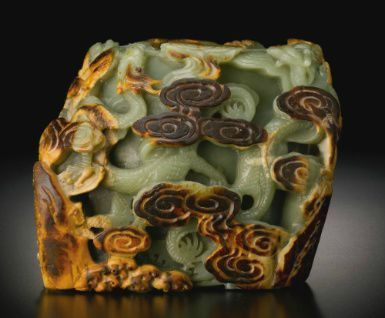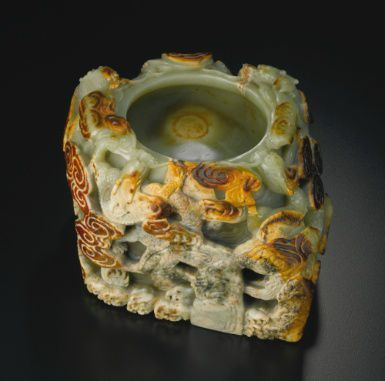A Large and Impressive Celadon Jade 'Dragon' Washer. 17th-18th Century
A Large and Impressive Celadon Jade 'Dragon' Washer. 17th-18th Century. Photo Sotheby's
carved from a single boulder, skillfully utilizing the stone's rhythmic shape to create a powerful design of five writhing five-clawed dragons amid swirling clouds, an inclusion in the stone artfully used to form a 'flaming pearl' that appears to glow in the interior of the well-hollowed receptacle, supported on a base carved as radiating waves with four mountains at the edges, the clever use of the yellowish-green stone's brown skin and opaque beige inclusions heightening the depth and three-dimensional effect of the design. Height 5 1/2 in., 14 cm - ESTIMATION 200,000-300,000 USD
NOTE DE CATALOGUE: Jade boulders of the size used to create the present lot would have been extremely rare, and the artist has tried to retain as much of the precious material as possible, utilizing the skin of the boulder and the different colored inclusions to convey a sense of depth. At the same time, the design of the dragons flying through swirling clouds conforms to the shape of the natural boulder without being confined by it. The resultant design is lively and animated.
In ancient China, five dragons represented the five directions, which referred to the four cardinal points and the center. Depictions of the five dragons therefore came to represent the worldly domain, stretching as far as the eye could see. Five dragons also represented the five elements of wood, fire, earth, metal, and water. These five elements were believed to be the basis from which all things were created, and represented everything under heaven. In addition, mountains or rocks rising from turbulent seas, a motif often appearing on Qing dynasty court robes, symbolized the mountains of longevity and the seas of blessings. They also represented the continents and the oceans and by extension the whole earth. Ancient Chinese believed that there were four oceans and five continents. Interestingly there are four mountains depicted on the present lot. Mencius believed that the role of the emperor was to 'stand at the center and stablize the four quarters' . It is conceivable that the emperor would represent the fifth continent and provide the stablizing force at the center of the universe, again going back to the idea of the five elements.
In view of this symbolism, and the large size of the jade boulder required to make this washer, it is not inconceivable that the present lot may have been used in the palace. The emperor would have had the resources required to acquire such a large piece of jade, and the symbolism suited him as he was the ruler of the realm in all directions, the master of all under heaven and the center of the universe.
A white and russet jade 'dragon' washer from the personal collection of Alan and Simone Hartman, ascribed to the Qianlong period, but with only three dragons, was sold at Christie's Hong Kong, 27th November 2007, lot 1504.
Sotheby's. Fine Chinese Ceramics & Works of Art, New York | 11 sept. 2012 www.sothebys.com

/https%3A%2F%2Fprofilepics.canalblog.com%2Fprofilepics%2F1%2F0%2F100183.jpg)
/https%3A%2F%2Fstorage.canalblog.com%2F03%2F02%2F119589%2F96711876_o.jpg)
/https%3A%2F%2Fstorage.canalblog.com%2F11%2F31%2F119589%2F94773502_o.jpg)
/https%3A%2F%2Fstorage.canalblog.com%2F20%2F83%2F119589%2F94772815_o.jpg)
/https%3A%2F%2Fstorage.canalblog.com%2F26%2F72%2F119589%2F75604929_o.jpg)
/https%3A%2F%2Fstorage.canalblog.com%2F59%2F60%2F119589%2F26458628_o.jpg)









/http%3A%2F%2Fstorage.canalblog.com%2F46%2F82%2F119589%2F129704536_o.jpg)
/http%3A%2F%2Fstorage.canalblog.com%2F02%2F19%2F119589%2F129119322_o.jpg)
/http%3A%2F%2Fstorage.canalblog.com%2F61%2F29%2F119589%2F129100630_o.jpg)
/http%3A%2F%2Fstorage.canalblog.com%2F39%2F57%2F119589%2F127899684_o.jpg)